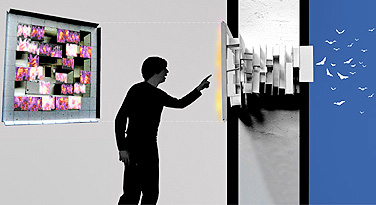News
Fellowship to support ‘pest architecture’

This preliminary rendering of Pest Wall shows a nest of plywood frames pressed together to form an accordion-like wall. The “pests” would not be able to gain access to the interior of the building, but “human” residents would be able to view their new neighbors.
-
 Print
Print -
 Comments
Comments
-
“The types of animals that people think of as being pests actually can be beneficial to have in an urban setting.”
Architecture faculty member Joyce Hwang will spend five weeks this spring at the nation’s oldest artists’ colony, where she will conclude a semester-long sabbatical devoted to a project she hopes to build in Buffalo: Pest Wall.
Hwang’s residency at the MacDowell Colony in Peterborough, N.H., will begin April 7 and end May 12. The colony, founded in 1907, nurtures the arts by giving architects, composers, filmmakers, writers and artists of all kinds an inspiring environment in which they can focus, free from distractions, on their work.
Hwang, an assistant professor who is taking the semester off from teaching, plans to use her time at MacDowell to complete the design of Pest Wall, an outdoor wall that houses bats and other “pests.”
She is assembling a team of students to work on the project, which she hopes to construct in Buffalo this summer.
Pest Wall will be the second prototype in a series of structures that draws attention to the importance of creatures such as insects and bats by creating a place for them in the built environment. Hwang’s first pest architecture project, Bat Tower, was a twisted, 12-foot-tall bat house that she and students erected beside a pond at Griffis Sculpture Park in Cattaraugus County last summer.
“The types of animals that people think of as being pests actually can be beneficial to have in an urban setting,” says Hwang. “Bats, for example, eat mosquitoes. Often times, if the animals are not well understood, there’s a fear of the unknown. And that’s unfortunate because a lot of animals are critical to the ecosystem.”
Hwang’s work on pest architecture has gained the attention of her peers in the U.S. and abroad. She delivered a talk on the subject in 2009 at “Animals and Animality Across the Humanities and Social Sciences,” a conference at Queen’s University in Ontario. Bat Tower has been featured in a range of publications online and in print, including The Chronicle of Higher Education, Good and AZURE magazine.
Bat Tower comprises five triangular segments stacked on top of one another, each with walls of finished plywood panels arranged in a ribbed, accordion-like pattern.
Some of Hwang’s initial concepts for Pest Wall share a similar quality, with pieces of carved plywood—some shaped like lightning bolts—cascading down the sides of buildings in tightly spaced layers.
Other preliminary renderings show a nest of plywood frames—all rectangular, but of different sizes—pressed together to form an accordion-esque wall.
The goal is to create openings that are comfortable for bats and maybe squirrels, but too small for larger, urban predators like raccoons.
Ideally, Hwang says, Pest Wall would be attached to an existing structure. While bats and other denizens would not be able to gain access to the interior of the chosen building, she has played with the idea of installing thermal cameras that would enable human residents to “see” their new, outdoor neighbors.
Hwang plans to finalize her drawings by May and begin construction soon after.
Once Pest Wall is complete, she’ll start thinking more about her next pest architecture project: “Pest Pavilion,” a freestanding, urban structure whose roof and walls would make a good home for bats.

Reader Comments